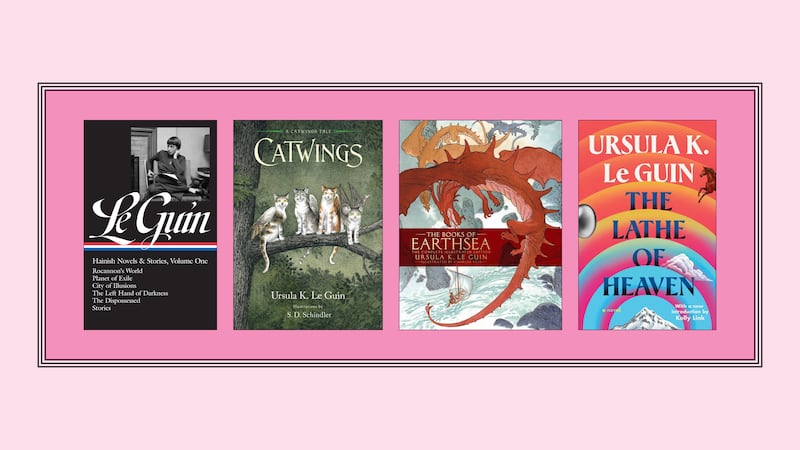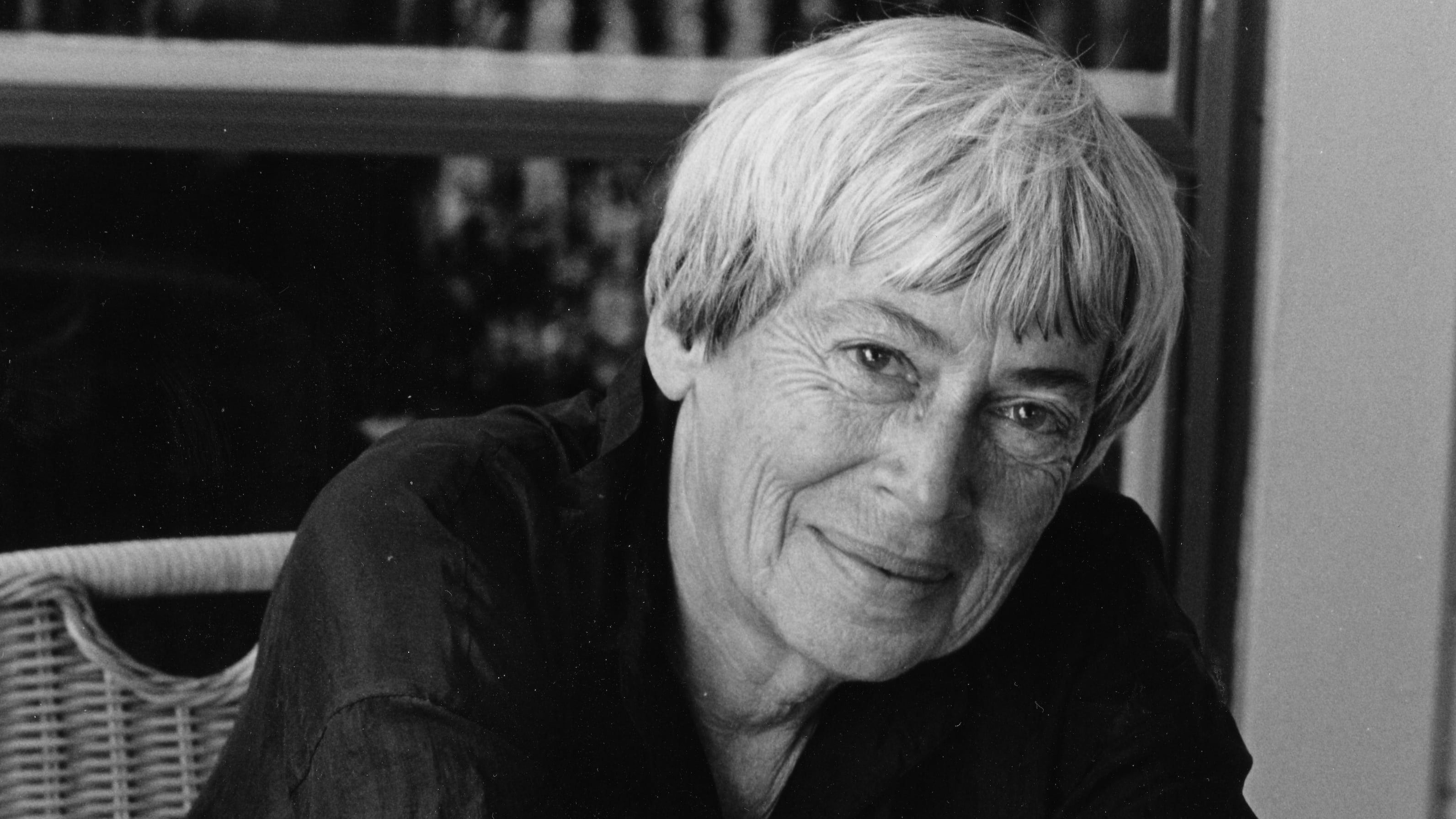How do you make a writer’s work and life come alive on the walls of an art gallery? Manuscripts, mugs of coffee, laptop computers with crumbs stuck in the keys—none of these is particularly visually compelling.
That’s the challenge facing the curators at Oregon Contemporary this week as they stage A Larger Reality, an ambitious new exhibition that will be up for more than three months. But luckily for them, the writer in question is the late canonical science fiction author Ursula K. Le Guin, known for her elaborate fantasy world-building. They have plenty of imagery to work with.
Lead curator Theo Downes-Le Guin (her son) and Oregon Contemporary’s executive and artistic director Blake Shell led a sneak peek tour last week during installation. The entry gallery contains an enormous map of the Earthsea archipelago and a 38-foot dragon painted directly on the walls of Oregon Contemporary. Later, there’s a video game-type experience based on her 1971 novel The Lathe of Heaven, four original artworks inspired by Le Guin’s literature, and holograms of her maps.
“I want the exhibition to be as engaging for someone who knows nothing as for someone who’s a superfan,” Downes-Le Guin says.
The exhibition A Larger Reality: Ursula K. Le Guin opens Oct. 31 and runs through Feb. 8, 2026. The takeaway: This is an extremely personal project with the participation of many family members and collaborators of Le Guin, all bringing their A games to do justice to the lauded author, who spent most of her life in Portland. Ursula K. Le Guin died in 2018 at the age of 88.
During the tour, muralist Ursula Barton was up on a ladder painting the dragon’s scales. Her first name is not a coincidence: Barton was named after Le Guin. (Her father, composer Todd Barton, was a longtime collaborator with the author and created a soundtrack to one of her books.) Ursula Barton has been a professional artist for 16 years but is finding herself under a lot of extra, self-imposed pressure while painting the Oregon Contemporary murals.
“I admired Ursula so much, and she has been an inspiration for women in the arts my whole life,” Barton says. “She was a big influence on what I could even see was possible for me. Making sure that I’m paying homage, and doing my best work to honor her, is very personal and heavy.”
The first conversations between Downes-Le Guin and Shell that led to A Larger Reality happened back in 2020. Shell invited Downes-Le Guin, who had just closed his Pearl District art gallery Upfor to become the full-time executor of his mother’s estate, to curate a show. The idea to have it be a biographical exhibition about his mother didn’t come to him right away, though.
“It’s kind of shocking to me that it took me two years to figure out how I wanted to use that very gracious opportunity that Blake presented,” Downes-Le Guin says. “Because this is bringing together two things I really love: my mother and curating.”
What the exhibition would look like was less obvious. What they’ve come up with is a thorough look at Le Guin’s writing and life through video, sculpture, visual art, maps and biographical objects. It’s a little beyond the scope of a typical art gallery show, Shell says.
“It’s given us this opportunity to connect with a lot of different disciplines,” Shell says. “And to have a really thoughtful exhibition about Ursula that is very creative in how it’s being presented. We’re up for all of the experiential things.”
They may be getting ahead of themselves a little bit, but Shell and Downes-Le Guin both harbor hopes that A Larger Reality will tour to other art galleries or museums once it closes its run at Oregon Contemporary.
There’s a re-creation of the valley oak tree that stands on Le Guin’s childhood Napa Valley ranch. Soft seating will surround the trunk, with a smattering of Le Guin books to sink into for those who have the time.
There’s also a to-the-inch re-creation of her writing studio in her Northwest Thurman Street home, complete with a typewriter that will produce short passages of Le Guin’s writing at the push of a button for visitors to take home. (The family donated the Willamette Heights home where Le Guin lived for 58 years to Literary Arts for writers’ residencies, which will begin in 2027.)
The biographical cases contain a plush toy of Le Guin’s from the 1930s, her poems and sketches, rejection letters from publishers, an annotated manuscript of 1972’s The Tombs of Atuan, and her 2014 National Book Foundation medal, among other objects. Spending day in and day out with his mother’s legacy can be overwhelming, Downes-Le Guin says.
“Wanting to get everything right is this constant internal dialogue. Is that the way she would talk about that? Is this what she would choose to highlight of her work? I can’t answer that. I’ll never know what the right answer is, and it’s not the right question to ask. As long as it’s honest and true to her as I understand her—which I think it is—then I did my job.”
SEE IT: A Larger Reality: Ursula K. Le Guin at Oregon Contemporary, 8371 N Interstate Ave., oregoncontemporary.org. Noon–5 pm Friday–Sunday, Oct. 31–Feb. 8. Free.

Hit the Books
Theo Downes-Le Guin curates a reading list of his mother’s writing.
The goal of A Larger Reality: Ursula K. Le Guin at Oregon Contemporary is that the exhibition is accessible to Le Guin superfans and science fiction newbies alike. That said, a walk-through of the show will surely be enhanced by a background in the legendary writer’s books and stories. (In a pinch, the 2018 Arwen Curry documentary Worlds of Ursula K. Le Guin lends a solid footing as well. The film screens at PAM CUT’s Tomorrow Theater on Nov. 2.)
We asked her son and the exhibition’s lead curator Theo Downes-Le Guin where he recommends that readers start with his mother’s oeuvre—no small query given that Le Guin published 22 novels, 11 volumes of short stories, 13 books for children, and more during the course of her life. Here’s his advice:
The Lathe of Heaven, a 1971 novel about a man named George Orr whose dreams can change reality. “It’s an extraordinarily trippy book,” Downes-Le Guin says. “But it does seem to be a book that resonates with a lot of people, and it’s set in Portland.”
“The Ones Who Walk Away from Omelas,” a 1973 short story about a utopian society that relies on one cruelty: a child locked in a cellar. “The moral conundrum that it presents is certainly engaging to people.”
The Catwings series of four children’s picture books. “For very young readers.”
Earthsea, a series of fantasy books starting with 1968’s A Wizard of Earthsea. “For YA readers, and into adulthood, especially if they seem like fantasy-leaning people.”
The Dispossessed, a 1974 novel about a planet of anarchists. “If someone seems very interested in politics and power, I would without a doubt send them to The Dispossessed. But that is somewhat diving into the deep end, if that’s the first book.”

